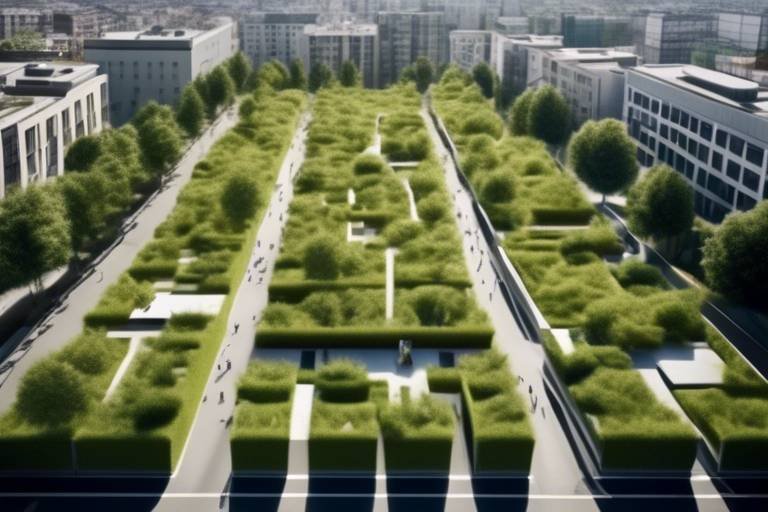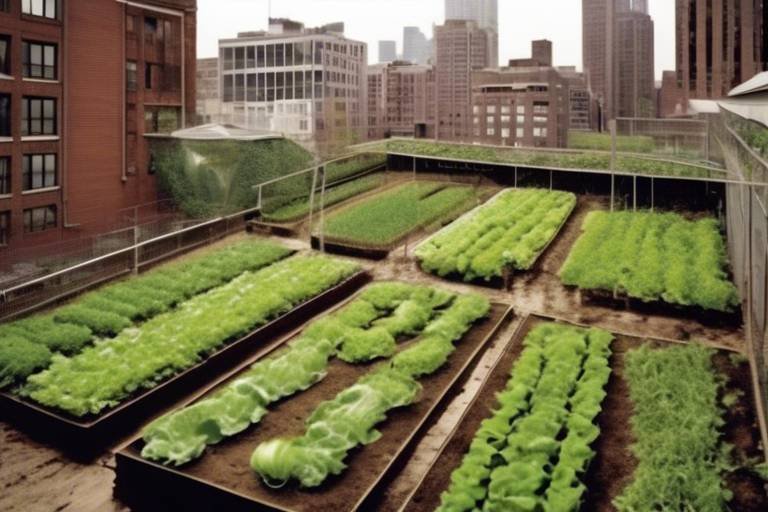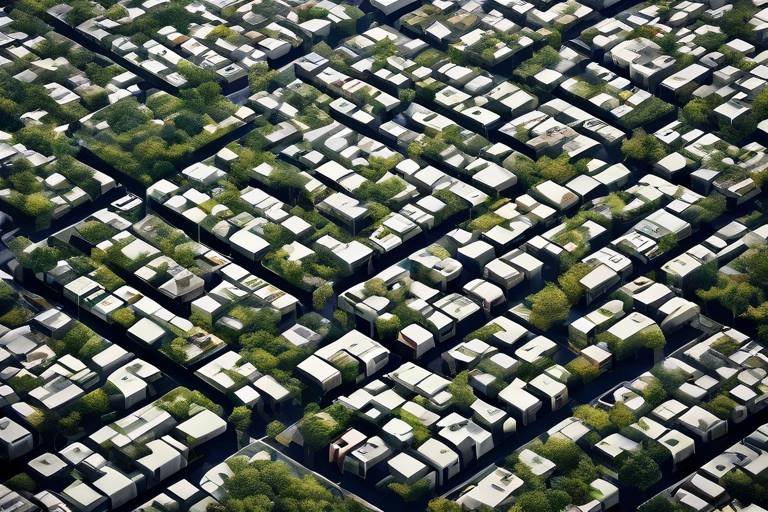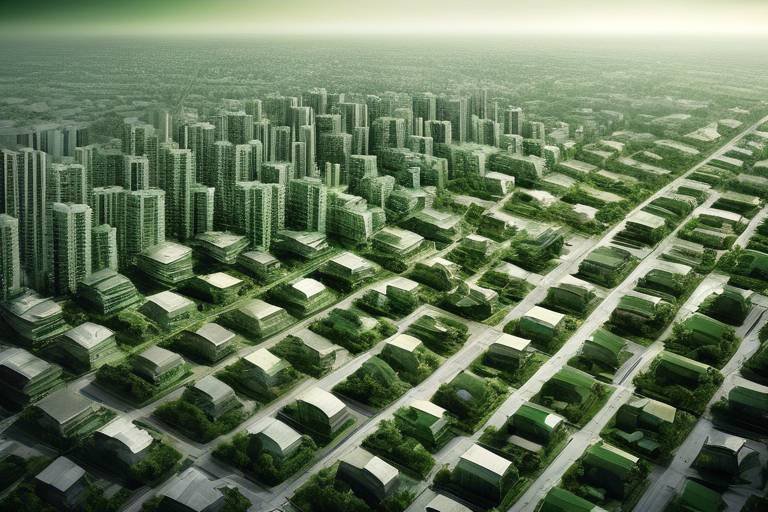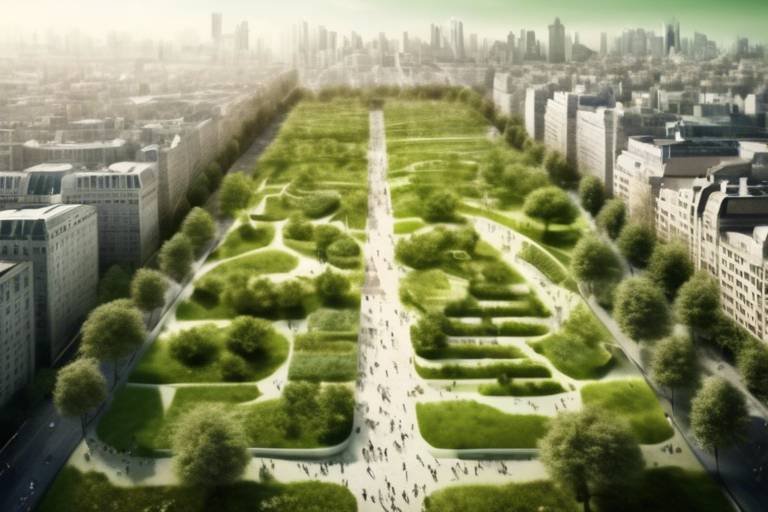The Role of Urban Green Spaces in Climate Change Mitigation
As cities continue to expand and populations grow, the **importance of urban green spaces** cannot be overstated. These pockets of nature serve not just as aesthetic enhancements but as vital components in our fight against climate change. Imagine walking through a park, surrounded by trees, flowers, and the sounds of nature. This experience isn’t just refreshing; it’s a crucial part of maintaining ecological balance in urban environments. Urban green spaces, including parks, gardens, and green roofs, play a multifaceted role in mitigating climate change effects while simultaneously enhancing the quality of life for city dwellers.
Firstly, urban green spaces significantly contribute to **biodiversity**. They provide habitats for various species, from birds to insects, fostering a rich ecosystem even within the concrete jungle. This biodiversity is essential for maintaining ecological health and resilience against climate impacts. Moreover, these areas act as natural air filters, absorbing pollutants and improving air quality. When we breathe cleaner air, we not only feel better but also reduce health problems associated with pollution, creating a healthier community overall.
In addition to these environmental benefits, urban green spaces offer recreational opportunities that are crucial for mental and physical well-being. Parks and gardens serve as gathering spots for families and friends, promoting social interaction and community cohesion. They provide spaces for exercise, relaxation, and even education about the environment. When communities engage with these green areas, they develop a sense of ownership and responsibility, which is vital for sustainable urban living.
Furthermore, the **carbon sequestration potential** of urban green spaces is a game changer in the battle against climate change. These areas act as carbon sinks, absorbing carbon dioxide from the atmosphere. Just think about it: a single mature tree can absorb approximately 48 pounds of carbon dioxide per year! This capacity to sequester carbon is crucial for reducing the greenhouse effect and combating global warming. The more green spaces we have, the greater our ability to mitigate climate change impacts.
To maximize the benefits of urban green spaces, we need to consider various types, including:
- Parks and Recreation Areas: These are essential for both recreation and wildlife habitats.
- Green Roofs and Walls: Innovative solutions that reduce heat and improve insulation.
- Community Gardens: Spaces that promote local food production and community engagement.
Each type of green space offers unique benefits and opportunities for enhancing urban biodiversity and climate resilience. By integrating these spaces into urban planning, cities can create a more sustainable future. The challenge lies in ensuring that these areas are accessible and well-maintained, which requires strategic planning and community involvement.
In conclusion, urban green spaces are not just a luxury; they are a necessity in our fight against climate change. They enhance biodiversity, improve air quality, provide recreational opportunities, and serve as crucial carbon sinks. As we move forward, it is essential for urban planners, policymakers, and communities to work together to expand and enhance these vital spaces. By doing so, we can create cities that are not only more livable but also more resilient to the challenges posed by climate change.
- What are urban green spaces? Urban green spaces are areas of vegetation in cities, such as parks, gardens, and green roofs, that provide environmental, social, and health benefits.
- How do urban green spaces help with climate change? They absorb carbon dioxide, improve air quality, provide habitats for wildlife, and offer recreational spaces for residents, all of which contribute to climate change mitigation.
- Can community involvement enhance urban green spaces? Absolutely! Engaging communities in the development and maintenance of green spaces fosters stewardship and increases awareness of environmental issues.

The Importance of Urban Green Spaces
Urban green spaces are not just patches of grass or a few trees scattered throughout a city; they are vital lifelines that contribute significantly to our environment, health, and overall quality of life. Imagine a bustling city, where the concrete jungle seems to swallow every ounce of nature. Now, picture vibrant parks, lush gardens, and tree-lined streets breaking up that monotony. These green areas create an oasis that not only enhances the aesthetic appeal of urban settings but also provides a multitude of environmental and social benefits.
One of the most compelling reasons to prioritize urban green spaces is their ability to enhance biodiversity. Cities can often be biodiversity deserts, but well-planned green spaces can attract various species of birds, insects, and other wildlife. This biodiversity is essential for maintaining ecological balance and resilience against climate change. Moreover, these spaces act as critical habitats for many species, allowing them to thrive even in urban environments.
Another significant benefit of urban green spaces is their role in improving air quality. Plants absorb carbon dioxide and release oxygen, acting as natural air filters. A study by the U.S. Forest Service found that urban trees alone remove over 700,000 tons of air pollution annually, significantly improving the air we breathe. This is particularly important in cities where pollution levels can skyrocket, leading to health issues such as asthma and other respiratory diseases.
Furthermore, urban green spaces provide essential recreational areas for communities. They serve as venues for social interaction, exercise, and relaxation, promoting mental well-being among residents. Think about it: a stroll in the park can be as refreshing as a day at the beach. These spaces foster a sense of community and belonging, encouraging people to engage with nature and each other. This social aspect is crucial for building resilient urban communities that are better equipped to face climate-related challenges.
However, the benefits of urban green spaces extend beyond just ecological and social factors. They also contribute to climate change mitigation by reducing urban heat islands, which are areas that experience significantly higher temperatures than their rural surroundings due to human activities. Trees and vegetation provide shade and release moisture into the air through a process called transpiration, helping to cool the surroundings. This cooling effect can lower energy consumption for air conditioning, thereby reducing greenhouse gas emissions.
In conclusion, urban green spaces are indispensable for fostering a sustainable urban environment. They enhance biodiversity, improve air quality, promote community well-being, and mitigate climate change effects. As we continue to develop our cities, it’s crucial to recognize the importance of integrating these green areas into urban planning and design. After all, a city with ample green spaces is not just a place to live; it’s a place to thrive.

Carbon Sequestration Potential
Urban green spaces are more than just pretty places to stroll or relax; they are powerful allies in the fight against climate change. One of the most significant contributions these areas make is their . But what exactly does that mean? In simple terms, carbon sequestration refers to the process of capturing and storing atmospheric carbon dioxide (CO2). Urban green spaces, such as parks, gardens, and even street trees, play a crucial role in this process by acting as natural carbon sinks.
Imagine a bustling city filled with concrete and steel, where the air is thick with pollution. Now, picture a vibrant park nestled in the heart of that city, filled with lush trees, blooming flowers, and chirping birds. This park is not just a sanctuary for people seeking a moment of peace; it is also a vital component of the urban ecosystem that helps absorb CO2 from the atmosphere. Through the process of photosynthesis, plants take in carbon dioxide, convert it into oxygen, and store carbon in their biomass—roots, stems, and leaves. This natural process is essential for reducing the overall concentration of greenhouse gases in our atmosphere.
To put the impact of urban green spaces into perspective, consider the following statistics:
| Type of Green Space | Average CO2 Sequestration (kg/year) |
|---|---|
| Urban Trees | 22-45 |
| Parks | 10-20 |
| Community Gardens | 5-15 |
As you can see, different types of green spaces contribute varying amounts of carbon sequestration. Urban trees, for instance, are champions in this regard, with their extensive root systems and large canopies. Parks also play a significant role, offering not just recreational spaces but also habitats for wildlife and opportunities for community engagement. Community gardens, while smaller in scale, still contribute to carbon absorption and enhance local biodiversity.
Moreover, the benefits of carbon sequestration extend beyond just reducing CO2 levels. These green spaces help mitigate the urban heat island effect, where city areas become significantly warmer than their rural surroundings due to human activities and infrastructure. By cooling the air and providing shade, urban green spaces can lower energy consumption for air conditioning, leading to further reductions in greenhouse gas emissions.
In addition to their direct environmental benefits, urban green spaces foster a sense of community and well-being. When people engage with nature, they are more likely to appreciate its value and advocate for sustainable practices. This connection between people and nature is vital for cultivating a culture of environmental stewardship, where individuals and communities work together to protect and enhance their local ecosystems.
In conclusion, the carbon sequestration potential of urban green spaces is immense. By integrating more parks, gardens, and trees into our cities, we can create healthier environments that not only combat climate change but also improve the quality of life for urban residents. It's a win-win situation—one that requires our attention, investment, and commitment to sustainability.
- What is carbon sequestration? Carbon sequestration is the process of capturing and storing atmospheric carbon dioxide to mitigate climate change.
- How do urban green spaces help with climate change? They absorb CO2, reduce heat, improve air quality, and enhance biodiversity.
- What types of urban green spaces are most effective for carbon sequestration? Urban trees, parks, and community gardens are all effective, with trees being the most impactful.
- Can I contribute to carbon sequestration in my community? Yes! You can plant trees, maintain gardens, and advocate for more green spaces in your area.

Types of Urban Green Spaces
When we think about urban green spaces, it’s easy to imagine sprawling parks filled with trees and families enjoying a sunny day. However, the reality is much richer and more diverse. Urban green spaces come in various forms, each offering unique benefits and opportunities for enhancing our cities’ ecological health. From the lush expanses of public parks to the innovative designs of green roofs, these spaces are vital in the fight against climate change.
Firstly, let’s talk about parks and recreation areas. These are often the heart of a community, providing not just a place for leisure and social interaction, but also serving as crucial habitats for local wildlife. Parks can absorb rainwater, reduce urban heat, and improve air quality, making them indispensable in urban planning. Imagine a park as a giant sponge, soaking up water and cooling the air around it. This cooling effect can significantly lower the temperature in densely populated areas, which is particularly important during those scorching summer months.
Next on the list are green roofs and living walls. These innovative structures are becoming increasingly popular in urban environments. They are not just aesthetically pleasing; they also provide a multitude of environmental benefits. Green roofs can reduce energy costs by enhancing insulation, while living walls can filter pollutants from the air. Think of them as nature’s air conditioning units, working tirelessly to keep our cities cooler and cleaner. Furthermore, these green installations can support biodiversity by creating habitats for birds, insects, and other wildlife right in the heart of the city.
Another fascinating type of urban green space is the community garden. These gardens are often managed and maintained by local residents, fostering a sense of ownership and community spirit. They serve as a vital resource for urban dwellers, providing fresh produce and educational opportunities about sustainable practices. Picture a community garden as a small oasis amidst the concrete jungle, where neighbors come together to cultivate not only plants but also relationships and knowledge about food production.
In addition to these, we must also consider green corridors. These are linear green spaces that connect parks and other natural areas, providing safe passage for wildlife and promoting biodiversity. They act like highways for nature, allowing animals to move freely between habitats and enhancing genetic diversity. This connectivity is crucial for the survival of many species, especially in urban areas where their natural habitats are fragmented.
Lastly, let’s not overlook the importance of urban forests. These are collections of trees that can be found within city limits, offering shade, beauty, and wildlife habitats. Urban forests play a significant role in carbon sequestration, helping to mitigate the effects of climate change. They act as the lungs of the city, absorbing carbon dioxide and releasing oxygen, which is vital for our survival. Imagine walking through an urban forest, feeling the cool shade on your skin and breathing in the fresh air—it’s a refreshing reminder of the power of nature in our lives.
In summary, the variety of urban green spaces—from parks and community gardens to green roofs and urban forests—offers a plethora of benefits that are essential for climate change mitigation. By integrating these spaces into our urban landscapes, we can create healthier, more resilient cities that not only thrive environmentally but also enhance the quality of life for their residents.
- What are urban green spaces? Urban green spaces are areas within cities that are covered with vegetation, including parks, gardens, green roofs, and urban forests.
- How do urban green spaces help in climate change mitigation? They absorb carbon dioxide, improve air quality, reduce urban heat, and enhance biodiversity, all of which contribute to combating climate change.
- Can community members participate in maintaining these spaces? Absolutely! Community engagement is key to the success of urban green spaces, and local residents often play a vital role in their upkeep.
- What benefits do parks provide? Parks offer recreational opportunities, improve mental health, support wildlife, and contribute to ecological health by reducing pollution and managing stormwater.

Parks and Recreation Areas
Parks and recreation areas are not just patches of green in our bustling cities; they are the lungs of urban environments, providing essential breathing space for both people and wildlife. Imagine stepping into a park after a long day in the office—suddenly, the noise of traffic fades away, and you’re enveloped by the sounds of rustling leaves and chirping birds. This transformation is vital, as parks serve multiple purposes that contribute significantly to climate change mitigation.
First and foremost, parks are **critical habitats** for various species, from birds to insects, fostering biodiversity that is essential for a balanced ecosystem. Biodiversity is like a safety net; it helps maintain ecological stability, making urban areas more resilient to climate impacts. Additionally, parks play a vital role in **carbon sequestration**. Trees and plants absorb carbon dioxide, a major greenhouse gas, thus helping to alleviate the effects of climate change. In fact, a well-maintained park can absorb substantial amounts of CO2, acting as a natural carbon sink.
Moreover, parks offer a plethora of recreational opportunities that promote physical and mental well-being. People flock to these green spaces for jogging, picnicking, or simply unwinding with a good book. The presence of parks encourages a more active lifestyle, which not only benefits individual health but also reduces reliance on carbon-emitting transportation methods. For instance, if more people walk or bike to parks instead of driving, the city sees a **decrease in emissions**, contributing to cleaner air.
But let’s not forget about the **social benefits** parks provide. They serve as communal gathering spots where people from diverse backgrounds can come together, fostering community spirit and engagement. This sense of community can lead to collective action towards sustainability initiatives, such as community gardening or tree-planting events. When residents feel a strong connection to their local environment, they are more likely to advocate for its protection and enhancement.
In addition to these benefits, parks can also help mitigate the **urban heat island effect**, a phenomenon where urban areas become significantly warmer than their rural surroundings due to human activities. The shade provided by trees and the cooling effect of water bodies in parks can lower temperatures, making cities more comfortable during heat waves. In this way, parks are not just recreational spaces; they are essential tools in our fight against climate change.
To maximize the benefits of parks, cities must invest in their **design and maintenance**. Well-planned parks that incorporate native plants, sustainable landscaping practices, and community input are more likely to thrive. Cities can also implement programs that encourage volunteerism for park maintenance, which not only improves the parks but also strengthens community ties.
In conclusion, parks and recreation areas are invaluable assets in urban settings. They provide essential ecological, social, and health benefits that contribute to climate change mitigation. As cities continue to grow and face the challenges of climate change, prioritizing the development and maintenance of parks is not just an option; it’s a necessity for a sustainable future.
- What are the main benefits of urban parks? Urban parks enhance biodiversity, improve air quality, provide recreational opportunities, and help mitigate climate change.
- How do parks contribute to carbon sequestration? Parks absorb carbon dioxide through trees and plants, acting as natural carbon sinks.
- Why are community engagement and education important for parks? Engaging the community fosters stewardship, increases awareness of climate issues, and encourages sustainable practices.
- What strategies can cities use to enhance their parks? Cities can invest in sustainable design, community involvement, and regular maintenance to maximize the benefits of parks.

Green Roofs and Walls
Green roofs and living walls are not just trendy additions to urban architecture; they are innovative solutions that play a significant role in climate change mitigation. Imagine a bustling city where the rooftops are not just barren slabs of concrete but vibrant ecosystems teeming with life. These green installations provide a plethora of benefits, transforming the urban landscape into a more sustainable environment.
One of the most compelling advantages of green roofs is their ability to reduce urban heat islands. In densely populated areas, concrete and asphalt absorb heat, causing temperatures to rise significantly. Green roofs, on the other hand, provide a cooling effect by absorbing sunlight and releasing moisture through evapotranspiration. This not only helps to keep buildings cooler but also reduces the need for air conditioning, which can lead to lower energy consumption and decreased greenhouse gas emissions.
Moreover, green roofs and walls enhance insulation, making buildings more energy-efficient. They act as a natural barrier against heat loss in winter and heat gain in summer, which can lead to substantial savings on energy bills. This dual functionality makes them an attractive option for both homeowners and businesses looking to minimize their carbon footprint.
In addition to their energy-saving capabilities, these green structures also provide crucial habitats for urban wildlife. Birds, insects, and other species find refuge in these green spaces, promoting biodiversity in areas where natural habitats have been lost. By integrating nature into our urban environments, we create not just a healthier ecosystem but also a more resilient city.
However, implementing green roofs and walls requires careful planning and consideration. Factors such as plant selection, irrigation systems, and structural integrity must be addressed to ensure their success. The right plants can thrive in these environments, providing not only aesthetic benefits but also functional ones, such as air purification and stormwater management.
To illustrate the impact of green roofs, consider the following table that highlights key benefits:
| Benefit | Description |
|---|---|
| Temperature Regulation | Helps mitigate urban heat islands by cooling the surrounding area. |
| Energy Efficiency | Improves insulation, reducing heating and cooling costs. |
| Biodiversity | Provides habitats for birds, insects, and other wildlife. |
| Stormwater Management | Absorbs rainwater, reducing runoff and preventing flooding. |
| Air Quality Improvement | Filters pollutants and carbon dioxide from the air. |
In conclusion, green roofs and walls are more than just beautiful additions to our cities; they are essential components of a sustainable urban future. By embracing these green technologies, we can enhance our urban environments, combat climate change, and foster a stronger connection between people and nature. So next time you look up at a building, imagine the potential it holds for transforming our cities into greener, healthier spaces.
- What are green roofs? Green roofs are rooftops covered with vegetation, providing insulation and reducing heat absorption.
- How do green walls benefit the environment? Green walls improve air quality, reduce noise pollution, and provide habitats for wildlife.
- Can any building have a green roof? Most buildings can support green roofs, but structural assessments are necessary to ensure safety and viability.
- What types of plants are suitable for green roofs? Drought-resistant and native plants are often recommended due to their low maintenance and adaptability.

Community Engagement and Education
Community engagement and education are pivotal in fostering a culture of sustainability and environmental stewardship in urban settings. When communities come together to participate in the development and maintenance of green spaces, they not only enhance the ecological value of these areas but also cultivate a sense of ownership and pride among residents. Imagine a neighborhood where everyone knows the local park's layout, the types of plants growing, and the wildlife that calls it home. This connection to nature can significantly influence how individuals perceive and act on climate issues.
One of the most effective ways to engage communities is through educational programs that highlight the benefits of urban green spaces. Workshops, guided nature walks, and hands-on gardening sessions can demystify the importance of biodiversity and carbon sequestration. These initiatives can be tailored to different age groups, ensuring that everyone—from children to seniors—can participate and learn. For instance, schools can partner with local parks to create educational programs that teach students about ecosystems, plant life, and the role of green spaces in climate change mitigation.
Moreover, community-led events such as tree planting days or clean-up drives not only beautify neighborhoods but also strengthen social bonds. When people work together towards a common goal, it fosters a sense of community and responsibility. Here are some key benefits of community engagement in urban green spaces:
- Increased Awareness: Engaging with local green spaces helps residents understand their direct impact on the environment.
- Enhanced Stewardship: A community that feels connected to its green spaces is more likely to protect and maintain them.
- Improved Mental Health: Participating in community activities outdoors can boost mood and reduce stress.
Furthermore, leveraging social media platforms can amplify community engagement. By sharing success stories, upcoming events, and educational content online, cities can reach a broader audience and encourage more people to get involved. Interactive campaigns, such as photo contests of local flora and fauna, can spark interest and participation among residents who might not have previously engaged with their local environment.
In conclusion, community engagement and education are essential components of successful urban green space initiatives. By fostering a culture of involvement, cities can not only enhance their green areas but also empower residents to take meaningful action against climate change. The more people understand the significance of these spaces, the more likely they are to advocate for their preservation and enhancement, creating a sustainable legacy for future generations.
Q: How can I get involved in my local green space initiatives?
A: You can start by contacting your local parks department or community organizations that focus on environmental issues. They often have volunteer opportunities or events that you can participate in.
Q: What are some easy ways to educate my community about green spaces?
A: Organizing workshops, creating informative flyers, and using social media to share tips and resources are great ways to spread awareness. You can also collaborate with schools to integrate environmental education into their curriculum.
Q: Why is community engagement important for climate change mitigation?
A: Community engagement fosters a collective sense of responsibility and encourages sustainable practices among residents, which can lead to more effective climate action at the local level.

Policy and Planning Strategies
When we talk about urban green spaces, it’s not just about planting a few trees or creating a park here and there; it’s about strategic integration into the very fabric of city planning. Effective urban planning and policy frameworks are absolutely essential to ensure that these green spaces are not only available but also accessible and beneficial to all city dwellers. Imagine a city where every resident has a green space within a 10-minute walk—sounds dreamy, right? Well, with the right policies, this can be a reality!
To achieve this, city planners need to adopt a holistic approach. This means considering various factors like population density, existing infrastructure, and community needs. For instance, in densely populated areas, vertical gardens and rooftop parks can serve as valuable green spaces. Additionally, policies should encourage the transformation of underutilized lots into community gardens or pocket parks. This not only beautifies the area but also promotes social interaction and community bonding.
Moreover, it’s crucial to involve local communities in the planning process. Engaging residents helps to foster a sense of ownership and responsibility towards these green spaces. When people feel connected to their environment, they are more likely to participate in its upkeep and protection. Community workshops and feedback sessions can be excellent platforms for gathering ideas and fostering collaboration between residents and planners.
Another essential aspect is funding. Securing financial resources for green space initiatives can be a challenge, but it’s vital for their success. Collaboration between government agencies, private sectors, and local communities can create a robust funding framework. For example, public-private partnerships can be a game-changer in financing urban green projects. By pooling together resources, cities can undertake larger and more impactful initiatives.
To ensure these strategies are effective, cities must also invest in measuring the impact of their green spaces. This involves assessing how these areas contribute to climate change mitigation, biodiversity, and community health. By using tools like geographic information systems (GIS) and environmental impact assessments, planners can identify successful strategies and areas needing improvement. This data-driven approach not only helps in refining existing policies but also in justifying future investments in green spaces.
Ultimately, the integration of urban green spaces into city planning is not merely an aesthetic choice; it’s a necessity for sustainable urban living. By prioritizing green spaces, cities can enhance their resilience against climate change while simultaneously improving the quality of life for their residents.
- What are urban green spaces? Urban green spaces are areas within cities that are covered with vegetation, including parks, gardens, and green roofs.
- How do urban green spaces help with climate change? They act as carbon sinks, improve air quality, and provide habitats for wildlife, all of which contribute to climate change mitigation.
- Can community involvement really make a difference? Absolutely! Community engagement fosters a sense of ownership and responsibility, leading to better maintenance and protection of green spaces.
- What types of policies are needed for effective green space planning? Policies should focus on strategic integration, funding, community engagement, and impact measurement to maximize benefits.

Funding and Resource Allocation
Securing funding for urban green space projects is not just a matter of financial support; it’s about creating a sustainable future for our cities. As urban areas continue to expand, the need for green spaces becomes increasingly critical. However, the challenge lies in effectively allocating resources to ensure that these projects are not only initiated but also maintained over time. Collaboration is key. It requires a partnership between government entities, private sectors, and local communities to prioritize climate action initiatives and ensure that funding is directed toward impactful projects.
One of the most effective ways to approach funding for urban green spaces is through a combination of public and private investment. Local governments can allocate budgetary resources specifically for green projects, while private companies can contribute through sponsorships or corporate social responsibility initiatives. Additionally, community fundraising efforts can play a significant role in securing funds. This collaborative approach not only helps in pooling resources but also fosters a sense of ownership among community members, making them more likely to engage in the upkeep and stewardship of these spaces.
Moreover, the allocation of resources should be guided by comprehensive planning that identifies the most underserved areas within urban landscapes. For instance, neighborhoods with limited access to parks and recreational areas should be prioritized for green space development. This ensures that the benefits of urban greening are equitably distributed, enhancing social cohesion and promoting health and well-being among residents. To illustrate this, consider the following table that outlines potential funding sources and their respective contributions:
| Funding Source | Type of Contribution | Potential Impact |
|---|---|---|
| Local Government | Budget Allocation | Provides foundational support for green projects |
| Private Sector | Sponsorships | Enhances project visibility and community engagement |
| Nonprofits | Grants | Supports innovative and community-driven initiatives |
| Community Fundraising | Local Events | Increases community involvement and ownership |
Ultimately, the success of urban green spaces hinges on a well-thought-out funding strategy that not only brings in the necessary resources but also encourages community participation and awareness. By working together, we can ensure that our cities are not just concrete jungles but vibrant ecosystems that support both people and the planet. As we look toward the future, it's essential to ask ourselves: how can we innovate funding strategies to keep our urban green spaces thriving? The answer lies in collaboration, creativity, and a shared vision for a greener, more sustainable urban environment.
- What are urban green spaces? Urban green spaces are areas within cities that are covered with vegetation, such as parks, gardens, and green roofs, which provide ecological, social, and health benefits.
- Why are funding and resource allocation important for green spaces? They ensure that green spaces are developed, maintained, and accessible to all community members, enhancing their effectiveness in climate change mitigation.
- How can communities get involved in funding efforts? Communities can engage in fundraising activities, volunteer for maintenance, and advocate for local government support for green space initiatives.

Measuring Impact and Effectiveness
Measuring the impact and effectiveness of urban green spaces is essential for understanding their role in climate change mitigation. Just like a gardener monitors the growth of plants to ensure they thrive, city planners and environmentalists must assess how these green areas contribute to ecological health and community well-being. This process involves a combination of quantitative and qualitative metrics that help paint a comprehensive picture of the benefits provided by urban greenery.
To effectively gauge the impact of urban green spaces, several key performance indicators (KPIs) can be utilized. These might include:
- Carbon Sequestration Rates: Measuring the amount of CO2 absorbed by trees and plants in parks and gardens can provide clear data on their effectiveness as carbon sinks.
- Biodiversity Index: Tracking the variety and population of species within green spaces can highlight their role in supporting urban wildlife.
- Air Quality Improvement: Monitoring changes in air quality before and after the implementation of green spaces can demonstrate their effectiveness in reducing pollutants.
- Community Engagement Levels: Surveys and participation metrics can indicate how well residents are connecting with and caring for their local green areas.
Moreover, it's crucial to apply these measurements over time. Just as a tree takes years to mature and provide shade, the benefits of urban green spaces may not be immediately visible. Therefore, longitudinal studies can help capture the evolving impact of these areas, revealing trends and patterns that inform future urban planning.
Additionally, employing technology such as Geographic Information Systems (GIS) can enhance the measurement process. GIS allows for spatial analysis of green spaces, helping to visualize their distribution and accessibility in relation to urban populations. This data can be invaluable for city planners aiming to create equitable and effective green infrastructure.
Another important aspect of measuring impact is gathering community feedback. Engaging residents in discussions about their experiences and observations can provide qualitative insights that numbers alone cannot capture. For instance, a community garden may not only provide food but also foster social connections, enhance mental well-being, and create a sense of belonging among residents. These subjective benefits are vital for understanding the holistic value of urban green spaces.
In summary, measuring the impact and effectiveness of urban green spaces requires a multi-faceted approach that combines scientific data with community input. By employing various metrics and tools, cities can ensure that their green spaces are not only beautiful but also functional and beneficial for climate change mitigation.
- What are urban green spaces? Urban green spaces are areas within cities that are covered by vegetation, such as parks, gardens, and green roofs. They provide numerous environmental and social benefits.
- How do urban green spaces help with climate change? They absorb carbon dioxide, improve air quality, reduce urban heat, and enhance biodiversity, all of which contribute to climate change mitigation.
- How can communities get involved in maintaining green spaces? Communities can engage by participating in local gardening initiatives, volunteering for clean-up days, or advocating for the creation of new green spaces.
- What metrics are used to measure the effectiveness of green spaces? Common metrics include carbon sequestration rates, biodiversity indices, air quality improvements, and community engagement levels.
Frequently Asked Questions
- What are urban green spaces?
Urban green spaces refer to areas within cities that are covered in vegetation, such as parks, gardens, and green roofs. They play a vital role in enhancing biodiversity, improving air quality, and providing recreational opportunities for communities.
- How do urban green spaces help in climate change mitigation?
These spaces act as carbon sinks, absorbing carbon dioxide from the atmosphere. By doing so, they help reduce the greenhouse effect and combat climate change, making cities more resilient to its impacts.
- What types of urban green spaces exist?
There are several types of urban green spaces, including public parks, community gardens, green roofs, and living walls. Each type offers unique benefits, such as recreational areas, biodiversity enhancement, and improved urban cooling.
- Why are parks important in urban areas?
Parks provide essential recreational opportunities, serve as habitats for wildlife, and contribute to the overall ecological health of urban environments. They also promote mental well-being and community cohesion.
- What role do green roofs play in urban sustainability?
Green roofs help reduce urban heat, improve insulation, and provide additional green space for plants. They enhance biodiversity and contribute to climate adaptation by managing stormwater and improving air quality.
- How can communities engage with urban green spaces?
Community engagement can occur through volunteering for maintenance, participating in local gardening initiatives, or attending workshops. This fosters stewardship and increases awareness of environmental issues.
- What policies support the development of urban green spaces?
Effective urban planning and policy frameworks are essential for integrating green spaces into city designs. These policies ensure accessibility, maintenance, and strategic placement to maximize climate benefits.
- How can funding be secured for urban green space projects?
Securing funding requires collaboration between government agencies, private sectors, and local communities. Prioritizing climate action initiatives can help attract necessary resources and support for these projects.
- How is the impact of urban green spaces measured?
The impact is assessed through various metrics, including biodiversity levels, air quality improvements, and community engagement. This helps identify successful strategies and areas needing improvement for effective climate action.

